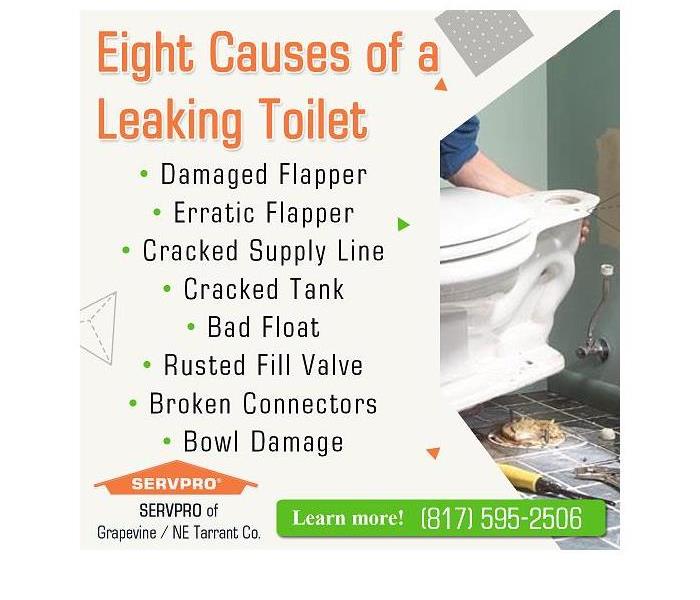SERVPRO: Common Causes of Leaking Toilets and How to Prevent the Potential Water Damage
7/14/2021 (Permalink)
Blog summary: The SERVPRO article educates about the causes of a leaking toilet as well as how to identify the problem and fix it.
8 causes of a leaking toilet
Ignoring a little leak in the toilet can quickly lead to a water damage situation that will not only cost money but a lot of time and inconvenience. However, homeowners can prevent this unnecessary escalation by being alert about the obscure leaks and being aware of the possible causes of these leaks. SERVPRO shares the various causes behind a leaky toilet that can be controlled if addressed in time.
- Damaged Flapper
The flapper is a rubber or plastic part that holds a seal to keep the water in the tank, a barrier between the tank and the bowl. When the flapper returns to its resting position, the tank fills with water again.
Flappers disintegrate over time. As they warp, crack, or break they are unable to control water flow between the tank and bowl. In this case, water often leaks from the tank into the bowl, creating an annoying, trickling sound. This silent leak is often hard to detect but it shows up on the inflated water bill.
Homeowners must watch out for any trickling sounds in the toilet. Once the bowl fills, you should not be able to notice any water trickling into it.
In case of a damaged flapper, homeowners can easily fix it at a low cost and prevent bigger water damage.
- Erratic Flapper
A toilet flapper in good condition may still not be functioning effectively. Often, flappers get stuck in the open position, allowing water to continually flow from the tank into the bowl.
Homeowners can identify this problem when the flushing handle feels limp and unresponsive. Check that the flapper is connected to the flushing handle. The replacement flapper, the mechanism that moves the handle up and down, may need to be replaced.
- Cracked Supply Line
With time or due to high pressure, the cold-water supply line that inputs water into the toilet’s tank may crack. This will become evident when there is water pooling around the toilet on the floor. If not addressed promptly by a professional plumber, this can advance into a flood situation.
To repair this without professional help, the water supply needs to be switched off, the cracked supply line must be removed cautiously, it should be coated with plumber’s tape, and then securely attached to the water valve and toilet. Be careful not to overtighten and test the new line to confirm there is no leak anymore.
- Cracked Tank
The presence of water on the floor around the commode indicates a cracked or broken tank. In this scenario, it is best to install a new toilet. Putty and sealants are only temporary fixes. A new toilet will ensure peace of mind.
- Bad Float
The float sits on top of the water in the tank, monitoring the water level and disengaging the supply when it reaches a certain level. An overflowing tank is usually indicative of a bad float.
Repairing the float is simple enough as a replacement float simply slips into place without tools or any effort.
- Rusted Fill Valve
If the tank is still overflowing after the above checkpoints, a corroded or damaged fill valve may be the culprit. The valve along with the float controls the amount of water that flows into the tank.
Replacing the valve is a little more tricky than replacing a float. Since there are multiple pieces to check and replace, it is ideal to shut off the water and await professional help.
- Broken Connectors
When connectors lose their seal, water lands up on the bathroom floor. Check for broken connectors and amend the situation swiftly to avoid water damage.
Replacing connectors is simple but may require a plumber’s assistance. It is advised to choose high-quality replacement parts to have longer-lasting protection from leaks.
- Bowl Damage
A hairline crack in the toilet bowl can expand into something more severe and lead to water leakage on the bathroom floor. Putty or glue is useless to seal cracks in porcelain or ceramic bowls and heightens the risk of spilling unhealthy wastewater on the floor.
If a structural part of the toilet is cracked and leaking, replacing the entire toilet is the best bet.
In case of water damage caused by leaking toilets, homeowners must contact a professional water damage restoration company such as SERVPRO to help mitigate and reverse the damage.
Why SERVPRO?
- SERVPRO uses state-of-the-art equipment to bring the damaged property back to its original state. SERVPRO of Grapevine / NE Tarrant County is constantly updating its fleet and equipment so clients in Southlake, Grapevine, Keller, or anywhere else can quickly access the services.
- With over 1,700 US and Canadian Franchise locations, SERVPRO is strategically positioned to respond faster to an emergency of any magnitude.
- The SERVPRO staff is highly trained in property damage restoration. They receive initial in-house training and constant skill up-gradation at the corporate training facility and also acquire the regular IICRC-industry certification.
For water damage restoration, call SERVPRO of Grapevine / NE Tarrant County today at (817) 595-2506 or e-mail at office@SERVPROheb.com






 24/7 Emergency Service
24/7 Emergency Service
